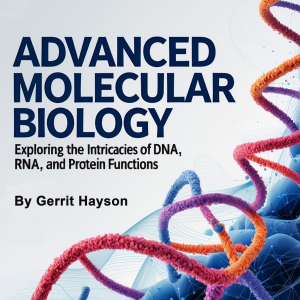

Advanced Molecular Biology
Gerrit Hayson
This audiobook is narrated by a digital voice.
The double helix stands as one of the most iconic structures in all of science, yet its elegant simplicity belies the extraordinary complexity of the processes it governs. Deoxyribonucleic acid, or DNA, serves as the fundamental blueprint for all known life on Earth, containing within its twisted ladder structure the instructions necessary to build, maintain, and reproduce every living organism from the smallest bacterium to the largest whale.
The discovery of DNA's structure in 1953 by James Watson and Francis Crick, building upon the crucial X-ray crystallography work of Rosalind Franklin, marked a turning point in our understanding of heredity and cellular function. This breakthrough revealed that DNA consists of two antiparallel strands wound around each other in a right-handed double helix, with the famous base pairs adenine with thymine and guanine with cytosine forming the rungs of this molecular ladder.
The chemical composition of DNA reflects its dual role as both an information storage system and a replication template. Each strand consists of a sugar-phosphate backbone, where deoxyribose sugar molecules are linked by phosphodiester bonds, creating a stable yet flexible framework. The nitrogenous bases extend inward from this backbone, forming hydrogen bonds with their complementary partners on the opposite strand. This complementary base pairing is crucial not only for structural stability but also for the accurate transmission of genetic information during DNA replication.
Duration - 40m.
Author - Gerrit Hayson.
Narrator - Digital Voice Madelyn G.
Published Date - Friday, 17 January 2025.
Copyright - © 2025 Gerrit Hayson ©.
Location:
United States
Description:
This audiobook is narrated by a digital voice. The double helix stands as one of the most iconic structures in all of science, yet its elegant simplicity belies the extraordinary complexity of the processes it governs. Deoxyribonucleic acid, or DNA, serves as the fundamental blueprint for all known life on Earth, containing within its twisted ladder structure the instructions necessary to build, maintain, and reproduce every living organism from the smallest bacterium to the largest whale. The discovery of DNA's structure in 1953 by James Watson and Francis Crick, building upon the crucial X-ray crystallography work of Rosalind Franklin, marked a turning point in our understanding of heredity and cellular function. This breakthrough revealed that DNA consists of two antiparallel strands wound around each other in a right-handed double helix, with the famous base pairs adenine with thymine and guanine with cytosine forming the rungs of this molecular ladder. The chemical composition of DNA reflects its dual role as both an information storage system and a replication template. Each strand consists of a sugar-phosphate backbone, where deoxyribose sugar molecules are linked by phosphodiester bonds, creating a stable yet flexible framework. The nitrogenous bases extend inward from this backbone, forming hydrogen bonds with their complementary partners on the opposite strand. This complementary base pairing is crucial not only for structural stability but also for the accurate transmission of genetic information during DNA replication. Duration - 40m. Author - Gerrit Hayson. Narrator - Digital Voice Madelyn G. Published Date - Friday, 17 January 2025. Copyright - © 2025 Gerrit Hayson ©.
Language:
English
Start
Duration:00:40:50